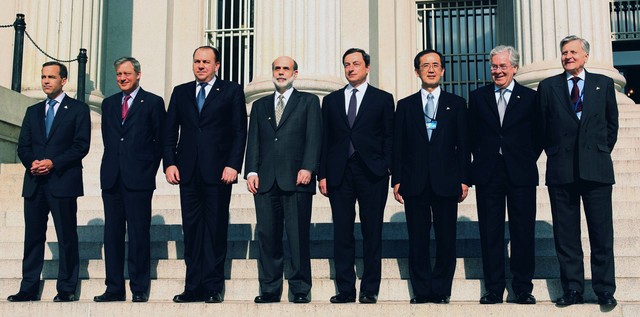Why Central Banks needs to be more clear in their message

AT TIMES markets and central banks resemble nothing so much as a quarrelsome couple. They pout at each other. They remonstrate. Above all, they struggle to communicate. Officials at the Federal Reserve and traders in financial markets have been talking past each other for much of the year—most recently in May, when the Fed sought to convince traders that a summer rate rise might be on the cards. The miscommunication is not entirely the fault of the central bank; a shaky world economy makes confident and clear messaging difficult. But that fragility also leaves central banks with less room for error. They should do better.
Not long ago, central bankers thought their job was best done in secrecy. A few reckoned the public could not be trusted to understand the finer points of monetary policy; others felt that catching markets unawares maximised the impact of a change in policy. In the 1980s central bankers rarely saw fit to inform the public of their near-term goals or even about past interventions. When called upon to speak in public, they did so with a practised opacity. Alan Greenspan, chairman of the Fed from 1987 to 2006, was an expert in “mumbling with great incoherence”.
In the 1990s, however, economists came to see transparency as a way to amplify rather than diminish the power of monetary policy. A better understanding of what a central bank is up to, they reasoned, should help investors anticipate its actions, thereby avoiding destabilising lurches in markets. That, in turn, should help central banks keep the economy running smoothly.As a first step, central banks clarified their policy goals by setting explicit targets for inflation. The Reserve Bank of New Zealand adopted one in 1990—an innovation many have followed. Next central bankers began revealing more about their assumptions and deliberations. A reform of the Bank of England in 1998 required it to explain its decisions, via the publication of minutes of its meetings and a detailed inflation report. In 1999 the Bank of Japan pioneered the tactic of “forward guidance”, when it promised to leave its interest rate at zero “until deflationary concerns subside” (they never did). Clear communication can be extraordinarily powerful. When Mario Draghi, president of the European Central Bank, declared in 2012 that he would do “whatever it takes” to save the euro, market sentiment abruptly reversed.
Unfortunately, central bankers tend to muck up their communications in three critical ways. First, they often obscure their message with lots of unhelpful noise. More information is better, but only to the extent that it makes future policy actions more predictable. Between meetings, Fed officials barnstorm around the country giving speeches. But their individual assessments of the economy are often a poor guide to the thinking of the monetary-policy committee as a whole.
When the Fed concludes its next meeting on June 15th, it will assault markets with a barrage of information: a statement about economic conditions, a summary of members’ economic projections (including an anonymised “dot plot”, showing where each member thinks interest rates ought to go over the next three years), and a press conference with the chairman, Janet Yellen. But these snippets often conflict: the dots suggest rates will rise steadily in coming years, keeping inflation consistently below 2%, even though Ms Yellen insists that the Fed is just as willing to overshoot its 2% target as undershoot it. This sort of ambiguity reduces both the power and the precision of Fed policy. (Despite that, the Bank of Japan announced a plan in 2015 to adopt many of the Fed’s communication strategies, including the dots.)
In a paper published in 2012, economists at the Federal Reserve Bank of Chicago described a second common flaw with forward guidance that can be even more damaging than cacophony. They distinguish between “Delphic” guidance—economic forecasts—and the “Odyssean” sort—a pledge to behave in a certain way (so named because one example might be promising to resist the siren song of rate increases even if inflation picks up). Some forward guidance could be read either way: the statement that rates are likely to remain low for a long time could mean that the central bank expects growth to be too weak to justify rate rises, in which case investors have good reason to stay pessimistic. But it could also represent a commitment not to raise rates even as growth accelerates, lifting expectations of future inflation and providing an incentive to borrow and invest in the present. A failure to distinguish between the two risks steering markets in the wrong direction.
Not so crystal clear
Now that the Fed has started tightening, it risks making a third mistake: being vague about how many times it intends to raise rates in order to avoid upsetting markets. Recent research by Jeremy Stein (a former Fed governor) and Adi Sunderam, both of Harvard University, suggests that markets see through attempts to serve big rate rises in small doses and begin reacting strongly to small rate shifts (thereby inducing still more caution in central bankers and more market overreaction). That does not mean that central bankers should raise rates steeply in one go, or commit to a particular path for hikes, when they are unsure how the economy as a whole will react. Rather, they should combine guidance about their preferred trajectory for interest rates with a clear statement about what would and would not trigger deviations from that plan.
It is only natural for central banks to be a little tentative in their initial experiments with a relatively new technique such as forward guidance. But in general things would work better if they were more coherent and more forthright. Indeed, the effort to speak more clearly might help monetary-policy committees to think more clearly.










